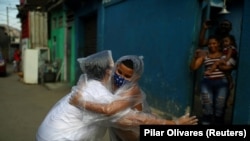During a July 23 media briefing, Brazil’s interim minister of health, Eduardo Pazuello, erroneously said that people infected with the coronavirus but not showing symptoms cannot pass the virus on to others.
Pazuello’s comment came as he responded to a question about his ministry’s proposals to reopen some areas of the country.
“You have to have screenings everywhere. If the [governor or mayor] decides to open an essential or production area,” he said, “there has to be a screening structure and medical monitoring of initial symptoms."
That strategy is accepted by most medical experts. But then Pazuello added:
“If the case is asymptomatic, [the employee] is working, but also doesn’t transmit [the virus]. If the case is symptomatic, he has to appear [at a testing center]."
The claim that asymptomatic people do not spread the virus is false.
To be sure, the notion of asymptomatic spread has been the subject of debate and intensive research. The issue rose in prominence on June 8, when a World Health Organization official suggested that such silent transmission was “very rare” and that asymptomatic patients were not driving virus spread.
The WHO walked it back the next day: “I used the phrase ‘very rare,’ and I think that that’s [a] misunderstanding to state that asymptomatic transmission globally is very rare. What I was referring to was a subset of studies,” said Dr. Maria Van Kerkhove, the WHO’s technical lead on the coronavirus pandemic, during a question-and-answer session.
She added that while the WHO couldn’t say how much virus is spread by asymptomatic carriers, it certainly happens.
That same day, Brazilian President Jair Bolsonaro, citing the WHO, asserted that the “the transmission through asymptomatic [people] is practically zero.” He suggested it could “signal to a faster opening of commerce and the extinction of those restrictive measures” that had closed stores and prohibited public gatherings. He did add, however, that “nothing is proven in the coronavirus issue.”
Asked about the issue on June 11, Dr. Anthony Fauci, the director of the U.S. National Institute of Allergy and Infectious Diseases, told ABC’s Good Morning America: "We know from epidemiological studies they can transmit to someone who is uninfected even when they're without symptoms.”
Evidence for silent spread
As the pandemic enters its fifth official month, numerous studies have found that symptomless transmission is spreading the virus.
The Washington Post reported on July 18 that studies trying to pinpoint the “patients zero” in outbreaks show commonalities among the likely sources – one being people who are infected but asymptomatic.
A recent study from China, which sampled the body surfaces of 13 COVID-19 patients (including two asymptomatic ones), revealed that asymptomatic people can contaminate their surroundings.
Another study by scientists at Italy’s University of Padova and Imperial College London, released on June 30, found that more than 40 percent of positive cases in Vò, a northern Italian town, showed no symptoms.
Confusing the matter is the distinction drawn between “asymptomatic” and “presymptomatic” cases.
Asymptomatic cases are those in which individuals test positive for coronavirus but never develop symptoms. But some of those who test positive while not showing symptoms develop them later. These cases are classified as presymptomatic.
Researchers have shown that individuals can spread the virus before developing symptoms – and may actually be most contagious during that time. It is possible that patients who are asymptomatic turn out to be presymptomatic and highly infectious.
The risk from such silent spread explains the importance of widespread testing – so that these a- or pre- symptomatic cases can be discovered early and quarantined.
A study by Chinese researchers, published in mid-April by the journal Nature Medicine, found that viral spreading began 2 to 3 days before the appearance of symptoms. By July, U.S. and Canadian researchers suggested that more than half of infections could be attributed to asymptomatic and presymptomatic “silent transmission.”
Also in July, the U.S. Centers for Disease Control and Prevention weighed in with an assessment based on multiple studies.
“[I]n the aggregate, these diverse studies suggest that SARS-CoV-2 can be transmitted by persons with presymptomatic or asymptomatic infection, which may meaningfully contribute to the propagation of the COVID-19 pandemic,” the CDC concluded.
Mixed signals in Brazil
Brazil has had more than 2.4 million COVID-19 cases and 87,000 deaths, second only to the United States, according to tracking by Johns Hopkins University & Medicine.
Recently, Brazil’s interim health minister has been promising transparency. Pazuello’s July 23 statements followed a record of mixed signals from Bolsonaro’s government, which critics say ignored health warnings while pushing to reopen the economy quickly.
Brazil’s Estado de São Paulo newspaper reported on July 22 that Pazuello had been alerted in May by a Health Ministry technical committee that, without isolation measures, it could take up to two years to control the pandemic. The minister nonetheless continued to push for reopening.
In June, Pazuello’s administration temporarily stopped publishing overall data on Covid-19 cases and deaths. Pazuello later said the change was only a proposal.
Bolsonaro himself has consistently minimized the dangers of COVID-19, initially describing it as a “small cold” and calling the alarm over the pandemic “hysterical.”
Then, on July 7, Bolsonaro said he tested positive for coronavirus and was taking the hydroxychloroquine – the controversial anti-malaria drug that hasn’t been proved effective on the virus. Two weeks later, Bolsonaro tested positive for the virus a third time.
On July 25, however, Bolsonaro said he’d tested negative and released a photo of himself with a box of hydroxychloroquine.
Pazuello, an army general who specializes in logistics, has no experience in health care. Since the outbreak, two Bolsonaro health ministers left their posts amid disagreements with him about isolation measures and the use of hydroxychloroquine.






